The Abitakijikokwe Discovery
Uncovering an Ojibwe Ancestor in Quebec Parish Records
Full Methodology
Marriage record from L'Annonciation, Oka, preserving the bride's Ojibwe name "Abitakijkok8e"
Research Strategy & Documentation Process
Initial Research Phase
Starting Point
Subject: Gabriel Guilbault, d. 1833, St-Benoit, Quebec
Initial Problem: First wife listed only as "unknown Indigenous woman" or "Sauvagesse"
Available Data: Gabriel's death record, second marriage to Josette Closier (1815)
Reverse Chronological Search
Located Gabriel's death record (April 8, 1833) - confirmed age 70
Found 1815 marriage identifying him as "widower of Josette Sauvagesse"
Calculated first wife's death between 1813-1814
Identified Gabriel's birthplace: L'Assomption (1762)
Geographic Clustering Strategy
Mapped potential parishes based on:
Fur trade routes (Ottawa River corridor)
Known Métis communities (Oka, Deux-Montagnes)
Gabriel's origin (L'Assomption) and death location (St-Benoit)
Traditional Ojibwe/Algonquin territory
Geographic reasoning of records - parishes searched along the Quebec-Ontario border:
1795-1805: St-Paul-de-Joliette (baptisms found)
1799-1803: L'Annonciation, Oka (marriage found)
1810-1820: Ste-Madeleine-de-Rigaud (death references)
1830-1835: St-Benoit (Gabriel's death)
Geographic clustering of records - parishes searched along the Quebec-Ontario border
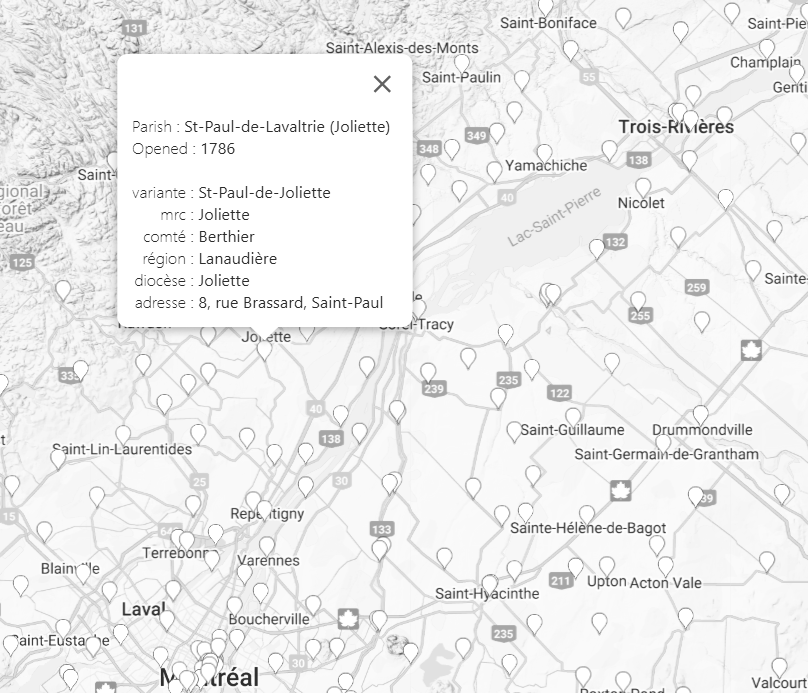
1795-1805: St-Paul-de-Joliette (baptisms found)

1799-1803: L'Annonciation, Oka (marriage found)

1810-1820: Ste-Madeleine-de-Rigaud (death references)

1830-1835: St-Benoit (Gabriel's death)
Breakthrough Discovery Phase
The 1798 Mass Baptism
Search Parameters: St-Paul-de-Joliette, 1795-1800, surname variations
Finding: October 10, 1798 - three children baptized together at St-Paul-de-Joliette
Critical details extracted:
Mother: "Josephte Sauvagesse, Sauteuse"
Children's ages indicated births from 1790-1797
Tribal identification: Sauteuse = Ojibwe/Saulteaux woman
This tribal specification was the key that unlocked everything
Pattern Recognition Applied
Identified search terms:
"Sauvagesse" (generic Indigenous woman)
"Sauteuse/Sauteux" (specific Ojibwe)
"de nation" (tribal member)
Spelling variants: Guilbault/Guilbeau/Guilbeault
Documentation Expansion Phase
Systematic Parish Review
Record Types Examined:
Baptisms (B)
Marriages (M)
Burials (S)
Notarial indices
The Marriage Record Discovery
January 27, 1801 - L'Annonciation, Oka
Full Indigenous name preserved: "M. Josephte Abitakijkok8e"
Four children legitimized
Witnesses with Indigenous names
The suffix "-ikwe" confirmed authentic Ojibwe name, meaning "woman" in the Ojibwe language
Significance: This document preserves her full Indigenous name and shows the Catholic Church's recognition of their pre-existing relationship "à la façon du pays."
Legal Continuity Spanning Centuries: An 1893 notarial document (58th sheet) still identified her as "Marie Josette Sauvagesse de nation" - maintaining her Indigenous identity in legal records 80 years after her death, demonstrating the enduring legal recognition of her Indigenous identity.
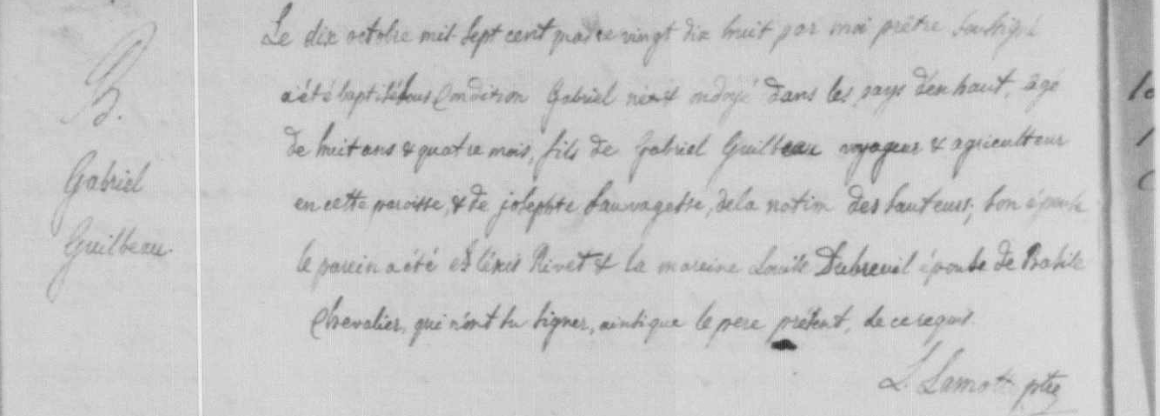
10 Oct 1798 Baptism - Gabriel Jr. Gabriel Jr.'s baptism identifying mother as "Josephte Sauvagesse, Sauteuse" - the first tribal identification
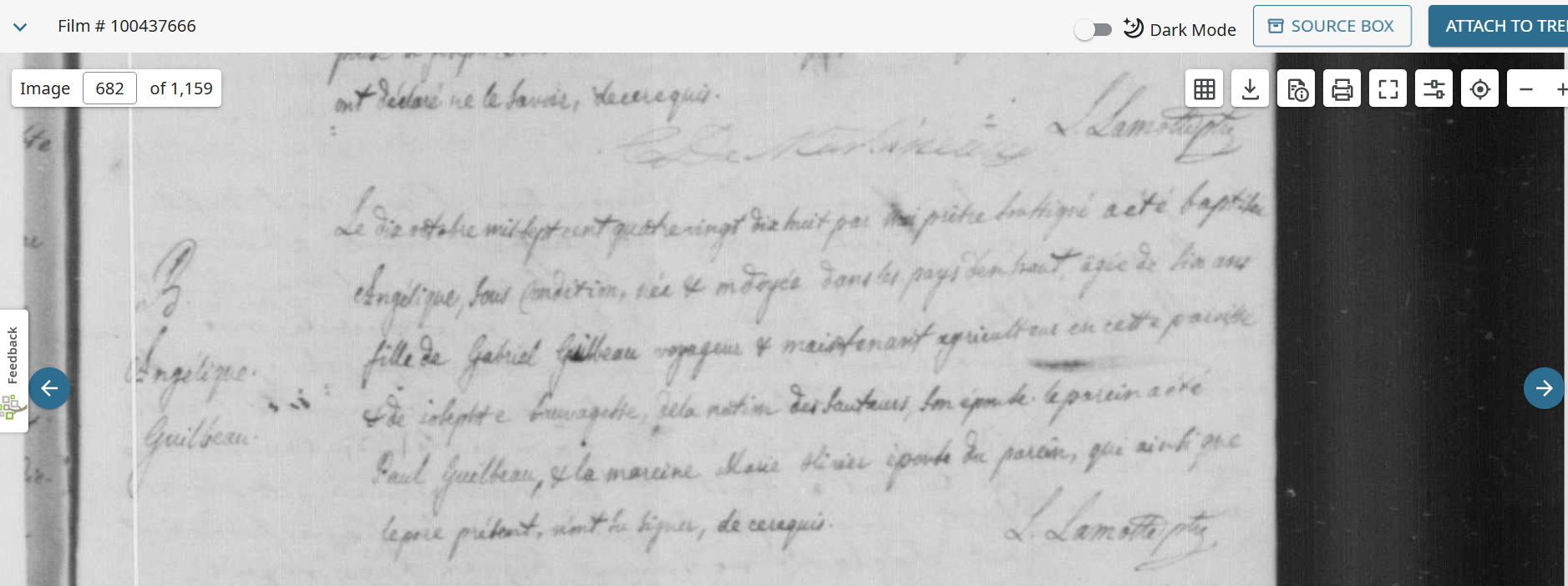
10 Oct 1798 Baptism - Angelique Same-day baptisms of Angelique and Joseph Claude, October 10, 1798

10 Oct 1798 Baptism - Joseph Claude Same-day baptisms of Angelique and Joseph Claude, October 10, 1798
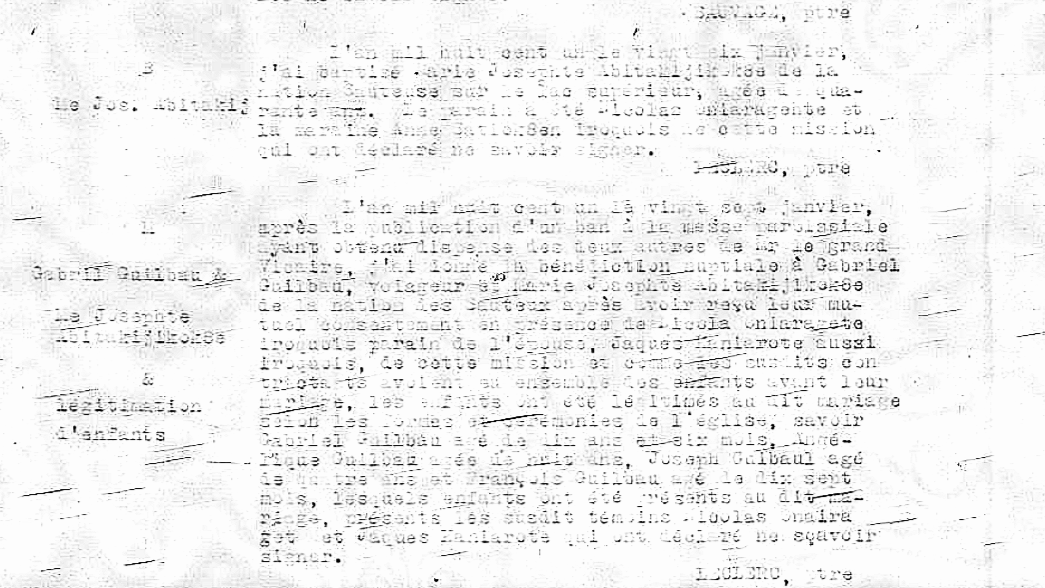
27 Jan 1801 Marriage Record The breakthrough document - Marriage record preserving "Abitakijkok8e"
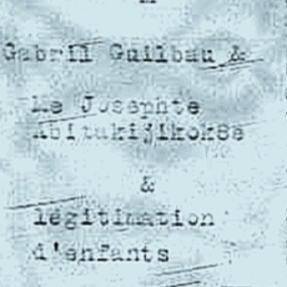
1801 Marriage Record (detail/close-up) Detail showing the Ojibwe name "Abitakijkok8e" written by the priest

1801 Marriage Record (detail/close-up) Detail showing the Ojibwe name "Abitakijkok8e" written by the priest
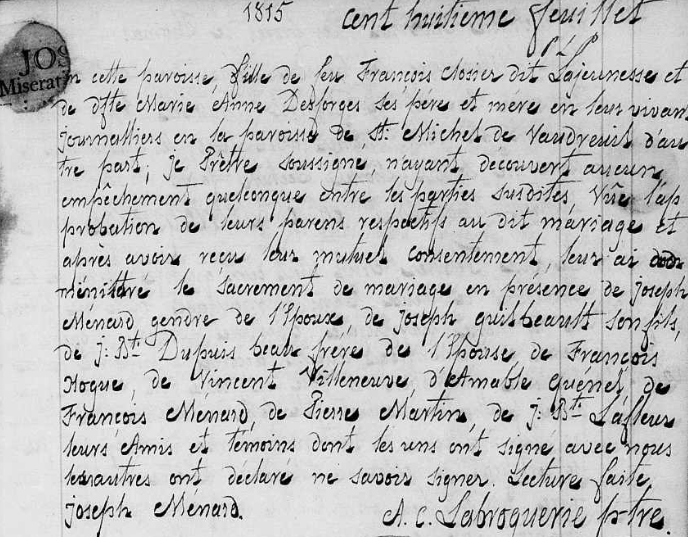
1815 Second Marriage Gabriel's 1815 remarriage identifying him as "widower of Josette Sauvagesse"

1893 Notarial Document Legal document still referencing "Marie Josette Sauvagesse de nation" 80 years after her death
Verification Phase
Cross-Reference Validation
Each child traced forward to establish complete family documentation:
Gabriel Jr. (b. June 1790):
FamilySearch Film #100437666, Image 683
Citation: https://familysearch.org/ark:/61903/3:1:3QSQ-G9JB-7FTN
Mother identified as "Sauteuse" (Ojibwe/Saulteaux)
Traced to adulthood with confirmed parentage
Angelique (b. ~1792):
FamilySearch Film #100437666, Image 682
Citation: https://familysearch.org/ark:/61903/3:1:3QSQ-G9JB-7FRB
Age at baptism: 6 years
Death: April 15, 1819
Joseph Claude (b. June 1797):
Same baptism record as siblings
Age at baptism: 16 months
Traced to adulthood
François (b. Sept 10, 1799):
FamilySearch Film #100437666, Image 707
Citation: https://familysearch.org/ark:/61903/3:1:3QSQ-G9JB-7NJJ
Died: April 3, 1801
Death Record: https://familysearch.org/ark:/61903/3:1:3Q9M-CSV5-TS5M-9
Complete birth-death cycle documented
Marie Louise (b. Jan 24, 1802):
Oka Parish Records
Citation: https://familysearch.org/ark:/61903/3:1:3Q9M-CSV5-TSPB-C
Mother listed as "Marie Josephte Tabitakijokoke"
Died: May 27, 1803
Death Record: https://familysearch.org/ark:/61903/3:1:3Q9M-CSV5-TSP1-4
Louis (b. 1806):
Baptismal record in parish registers
No death record found in searched parishes
Likely survived to adulthood
Name Analysis
"Abitakijkokwe" Deconstruction:
Recognized Algonquian language structure
The suffix "-ikwe" means "woman" in Ojibwe
Consistent with Ojibwe naming patterns
Various spellings in records (Abitakijikokwe, Abitakijkok8e, Tabitakijokoke) reflect French attempts to phonetically record an Ojibwe name
Gabriel's Second Marriage - Confirming Timeline
February 6, 1815 - Sainte-Madeleine-de-Rigaud
FamilySearch Film, Image 449 of 540
Citation: https://familysearch.org/ark:/61903/3:1:3QS74-993-W5QX
Gabriel identified as "widower of Josette Sauvagesse"
Confirms Marie Josephte's death before 1815
Reaffirms her Indigenous identity in official records
Research Tools & Techniques
Databases Utilized
FamilySearch:
Quebec Catholic Parish Records
Film #100437666 (St-Paul-de-Joliette baptisms)
Film #008130869 (L'Annonciation marriage record)
Full Text Search Feature: Critical to this discovery - allowed searching within handwritten document content rather than just indexed fields, enabling discovery of records not indexed under the Guilbault name variations but containing references to "Sauvagesse" and "Sauteuse" within the document text
Ancestry.com:
Drouin Collection
Quebec Vital Records
Archives Nationales du Quebec:
Notarial records
Parish duplicates
Language Considerations
French paleography skills required
Understanding of Latin sacramental formulas
Recognition of Ojibwe linguistic patterns
Historical French-Canadian spelling variations
Critical Success Factors
What Made This Case Solvable:
Priests who recorded rather than erased Indigenous identity - Unlike many colonial records that omitted Indigenous names entirely, the priests in these parishes chose to preserve Marie Josephte's Ojibwe name and tribal affiliation
Mass baptism creating clustered records - The October 10, 1798 baptism of three children together at St-Paul-de-Joliette provided concentrated information and established the family unit
Preservation of Indigenous name in marriage record - Despite an 11-year gap between the relationship's start (~1789-1790) and the 1801 Catholic marriage, the priest recorded her full Ojibwe name
Consistent geographic area (didn't migrate far) - The family remained within the Quebec-Ontario border region, allowing systematic parish-by-parish searches
Notarial records providing late confirmation - Legal documents maintained her Indigenous identity decades after death, providing verification points
Obstacles Overcome:
15+ spelling variations of surnames (Guilbault/Guilbeau/Guilbeault)
Missing direct death record for Marie Josephte
Language barriers (French/Latin/Ojibwe)
Geographic spread across multiple parishes
Time gap between relationship start (1790) and marriage (1801)
Historical Context
Fur Trade Society
Marie Josephte's union with Gabriel Guilbault represents a typical fur trade marriage pattern:
Initial Union (c.1789-1790): Relationship began "à la façon du pays" (according to the custom of the country)
Children Born (1790-1799): Four children born before Catholic marriage
Church Marriage (1801): Formalization of existing relationship
Legitimization: Children recognized and legitimized by the ChurchVerification Phase
Métis Identity Formation
This family represents classic Métis ethnogenesis:
French-Canadian voyageur father
Ojibwe/Saulteaux mother
Children raised between two cultures
Continued recognition of Indigenous heritage in subsequent generations
Geographic Context
The Oka/Deux-Montagnes region was home to established Indigenous communities. The location along the Ottawa River was traditional Ojibwe/Algonquin territory and a major fur trade route, connecting Gabriel's work as voyageur with Indigenous trading networks.
Genealogical Proof Standard Analysis
Source Evaluation
Original Sources: 15+ primary documents spanning 1790-1893
Church baptismal records (6 children documented)
Marriage register (1801)
Burial records (children François and Marie Louise)
Gabriel's second marriage record (1815)
Notarial documents (1893)
Independent Corroboration: Multiple parishes, record types, spanning nearly a century
Information Quality: Direct, primary information from contemporary records
Evidence Classification: Direct evidence of Indigenous identity through consistent tribal identification and preservation of Ojibwe name
Conflict Resolution
Apparent Conflicts Addressed:
Age discrepancies (resolved: estimation ranges normal for the period)
Name variations (resolved: phonetic spellings of Ojibwe name by French priests)
Multiple spellings of surname (resolved: standardized spelling did not exist)
Correlation & Analysis
All records consistently identify Indigenous status across 103 years (1790-1893)
Geographic locations align with fur trade patterns
Chronology supports family formation narrative following "à la façon du pays" custom
Witness networks in marriage record confirm community connections
Documentation Strength: EXCEPTIONAL
Multiple primary sources spanning 1798-1893
Consistent identification as Indigenous woman across all records
Preservation of Indigenous name in official documents
Both church and civil recognition of Indigenous identity
Genealogical Proof Standard: MET
✓ Reasonably exhaustive research across multiple parishes and record types ✓ Complete and accurate citation of all sources ✓ Thorough analysis and correlation of evidence ✓ Resolution of conflicting evidence through contextual understanding ✓ Sound written conclusion supported by evidence
Lessons Learned
Key Takeaways:
Indigenous ancestors can be documented in colonial records when priests chose to record rather than erase identity
Persistence through spelling variations essential - both for surnames and Indigenous names
Understanding historical context crucial - knowledge of fur trade customs and "à la façon du pays" marriages
Multiple record types provide fuller picture - baptisms, marriages, burials, and legal documents all contributed
Legal documents can preserve identity long-term - the 1893 notarial record proved enduring recognition
Reproducible Strategies:
Start with known fur trade communities (Oka, Deux-Montagnes, along Ottawa River)
Search for cultural identifiers, not just names (Sauvagesse, Sauteuse, "de nation")
Check witnesses/godparents for community networks and Indigenous names
Review all children's records, not just direct line - siblings' records often contain crucial information
Examine legal documents decades after death for continued identity recognition
Use Full Text Search features when available to find records not captured in traditional indexes
Technology Note:
FamilySearch Full Text Search Feature: Critical to this discovery was the recently implemented Full Text Search capability on FamilySearch, which allows searching within the actual handwritten content of documents rather than just indexed fields. This tool enabled the discovery of records that weren't indexed under the Guilbault name variations but contained references to "Sauvagesse" and "Sauteuse" within the document text. This represented a breakthrough in genealogical research methodology.
Final Assessment
This case represents exceptional documentation for an Indigenous ancestor in colonial records. The preservation of Marie Josephte Abitakijikokwe's Ojibwe name, consistent tribal identification, and legal recognition across nearly a century (1790-1893) makes this one of the most thoroughly documented Indigenous women in Quebec parish records.
Her descendants can claim with full documentary confidence their Métis heritage through this Ojibwe matriarch.
The methodology employed—combining systematic searching, pattern recognition, linguistic analysis, and historical context—can be applied to other challenging Indigenous ancestry cases, though results this comprehensive remain rare.
For a detailed guide on recognizing these patterns, request our free resource: "Five Signs of Indigenous Ancestry in Quebec Parish Records"
L'Annonciation Church at Oka today-This sacred place, at the confluence of Indigenous and French cultures, holds the marriage register where her Ojibwe name was preserved on January 27, 1801."
Read “Finding Marie Josephte: How One Ojibwe Woman Emerged from 200 Years of Silence”
See another complex family mystery solved : The Owen Hamall Mystery
Contact Storyline Genealogy to discuss your genealogical goals

